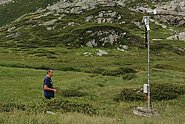Capturing data in the field is essential for both research and avalanche warning activities. Data is collected either by the automated IMIS stations or manually. Alongside observations, assessments and modelling, measured values rank among the most important fundamental data for generating avalanche bulletins.
IMIS measuring network ¶
The Intercantonal Measurement and Information System (IMIS) currently consists of 189 measuring stations (2023). They are distributed throughout the Swiss Alps and the Jura region and, in most cases, are situated above the tree line, most frequently between 2000 and 3000 m. The stations record the conditions around the clock every 30 minutes.
Most IMIS stations are located in the vicinity of starting zones of potentially destructive avalanches, and provide those who are responsible locally for public safety in settlements and on the roads with essential information. They are also used by the avalanche warning service of the SLF, for snow-hydrological and research purposes. Data is also exchanged with MeteoSwiss and other partners.
The IMIS network comprises snow, wind and specialised stations. The snow and wind stations are usually situated close to each other and measure the key weather data required for assessing the avalanche danger.
IMIS snow stations ¶
Snow stations are erected in flat terrain that is protected from the wind. The snowpack model SNOWPACK calculates the layering and properties of the snowpack throughout the winter for each of the IMIS snow stations. The results are not only essential for determining the amount of fresh snow, but also give an indication of the bonding of the snowpack, the formation of surface hoar and snowdrift accumulations, and of increasing moisture throughout the snowpack, which is a symptom of imminent wet-snow avalanches.
The following variables are measured in the standard programme:
- Snow depth (current data)
- Air and surface temperature (current data)
- Wind speed and direction
- Relative humidity
- Reflected shortwave radiation
- Ground temperature
- Snow temperature 25 cm, 50 cm and 100 cm above the ground
- Rain (rain gauge, most of the stations)
IMIS wind stations ¶
Wind stations are generally situated at higher altitudes on exposed summits or ridges.
The following variables are measured in the standard programme:
- Wind speed and direction (current data)
- Air temperature
- Relative humidity
Specialised stations
Apart from the conventional snow and wind stations, the IMIS network also includes a number of specialised stations:
- Slope snow stations are situated not in flat terrain but closer to the starting zones of problematic avalanche paths, and sometimes immediately alongside artificial avalanche triggering systems.
- Snowdrift stations are usually situated on broad ridges that are exposed to the wind, and measure the sound of colliding snow particles. The results are used to determine the intensity of snow transportation.
Installation and operation ¶
Construction of the IMIS network began in1996. IMIS is funded by the Swiss Federal Office for the Environment (FOEN), cantonal and district authorities, and others. The SLF has been commissioned to operate the central office and manage the project, and collaborates closely with external contractors entrusted with the maintenance of the facilities.
The IMIS stations operate autonomously. Power is supplied to each station by a solar panel in combination with a battery. Although the only feasible option in the Alps, this arrangement precludes the use of the heated and ventilated sensors that are specified in conventional meteorological standards. In wintertime the equipment is occasionally subjected to temporary outages if it becomes iced up or encrusted with hoarfrost. If the solar panel is coated in hoarfrost for an extended period, the power supply can eventually run out (within around four to six weeks in many cases). In these circumstances the entire station fails. In the summer months, the exposed wind stations in particular are regularly struck by lightning. Further typical faults that affect the measurement of snow, temperature and wind are described under current data.
In the autumn, experts are flown to the sites of all stations to carry out maintenance work. Faults are repaired in accordance with their seriousness, sometimes promptly. Given that many IMIS stations are difficult to reach, however, action cannot always be taken immediately. The visualisation platforms not display error messages to draw attention to the temporary unavailability of individual sensors or entire IMIS stations.
Links ¶
Contact ¶
The warning and information systems group is responsible for operating and maintaining the IMIS stations.
imis@slf.ch
081 417 01 11



